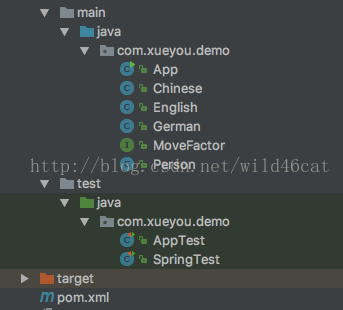spring @profile注解的使用方法
本文主要介绍spring中@profile的使用方法以及在什么情况下使用。
首先说一下为什么要使用这个@profile注解。@profile注解是spring提供的一个用来标明当前运行环境的注解。我们正常开发的过程中经常遇到的问题是,开发环境是一套环境,qa测试是一套环境,线上部署又是一套环境。这样从开发到测试再到部署,会对程序中的配置修改多次,尤其是从qa到上线这个环节,让qa的也不敢保证改了哪个配置之后能不能在线上运行。
为了解决上面的问题,我们一般会使用一种方法,就是配置文件,然后通过不同的环境读取不同的配置文件,从而在不同的场景中跑我们的程序。
那么,spring中的@profile注解的作用就体现在这里。在spring使用DI来依赖注入的时候,能够根据当前制定的运行环境来注入相应的bean。最常见的就是使用不同的DataSource了。
下面详细的介绍一下,如何通过spring的@profile注解实现上面的功能。
首先是新建maven工程
mvn archetype:generate -DarchetypeCatalog=internal
下面是pom文件:
<properties>
<project.build.sourceEncoding>UTF-8</project.build.sourceEncoding>
<springframework.version>4.3.7.RELEASE</springframework.version>
</properties>
<dependencies>
<dependency>
<groupId>junit</groupId>
<artifactId>junit</artifactId>
<version>4.12</version>
<scope>test</scope>
</dependency>
<!-- https://mvnrepository.com/artifact/org.springframework/spring-context -->
<dependency>
<groupId>org.springframework</groupId>
<artifactId>spring-context</artifactId>
<version>${springframework.version}</version>
</dependency>
<!-- https://mvnrepository.com/artifact/org.springframework/spring-test -->
<dependency>
<groupId>org.springframework</groupId>
<artifactId>spring-test</artifactId>
<version>${springframework.version}</version>
</dependency>
</dependencies>
<build>
<plugins>
<plugin>
<groupId>org.apache.maven.plugins</groupId>
<artifactId>maven-compiler-plugin</artifactId>
<configuration>
<source>1.8</source>
<target>1.8</target>
<encoding>utf-8</encoding>
</configuration>
</plugin>
<plugin>
<artifactId>maven-assembly-plugin</artifactId>
<version>3.0.0</version>
<configuration>
<archive>
<manifest>
<mainClass>com.xueyou.demo</mainClass>
</manifest>
</archive>
<descriptorRefs>
<descriptorRef>jar-with-dependencies</descriptorRef>
</descriptorRefs>
</configuration>
<executions>
<execution>
<id>make-assembly</id> <!-- this is used for inheritance merges -->
<phase>package</phase> <!-- bind to the packaging phase -->
<goals>
<goal>single</goal>
</goals>
</execution>
</executions>
</plugin>
</plugins>
</build>
整体看一下工程中的类和接口:

首先是Person类中有一个speak的方法,这个方法是MoveFactor这个借口提供的。Chinese、English和German都实现了这个接口。但是这三个类的@profile中的值是不同的。通过SpringTest中分配不同的activeprofile就能够实现调用不同的speak方法。
下面看代码:
MoveFactor.interface
package com.xueyou.demo;
public interface MoveFactor {
void speak();
}
Person.java
package com.xueyou.demo;
import org.springframework.beans.factory.annotation.Autowired;
import org.springframework.stereotype.Component;
@Component
public class Person {
@Autowired
private MoveFactor moveFactor;
public void speak(){
moveFactor.speak();
}
}
Chinese.java
package com.xueyou.demo;
import org.springframework.context.annotation.Configuration;
import org.springframework.context.annotation.Profile;
import org.springframework.stereotype.Component;
@Configuration
@Profile(value = "dev")
@Component
public class Chinese implements MoveFactor {
@Override
public void speak() {
System.out.println("我是中国人");
}
}
English.java
package com.xueyou.demo;
import org.springframework.context.annotation.Profile;
import org.springframework.stereotype.Component;
@Component
@Profile("qa")
public class English implements MoveFactor{
@Override
public void speak() {
System.out.println("i am an English");
}
}
German.java
package com.xueyou.demo;
import org.springframework.context.annotation.Profile;
import org.springframework.stereotype.Component;
@Component
@Profile("prod")
public class German implements MoveFactor{
@Override
public void speak() {
System.out.println("i am a German");
}
}
使用springtest进行测试
package com.xueyou.demo;
import org.junit.Test;
import org.junit.runner.RunWith;
import org.springframework.beans.factory.annotation.Autowired;
import org.springframework.test.context.ActiveProfiles;
import org.springframework.test.context.ContextConfiguration;
import org.springframework.test.context.junit4.SpringJUnit4ClassRunner;
@RunWith(SpringJUnit4ClassRunner.class)
@ContextConfiguration(classes = App.class)
@ActiveProfiles("dev")
public class SpringTest {
@Autowired
Person p;
@Test
public void testProfile(){
p.speak();
}
}
运行结果:

当修改@ActiveProfile中的值时,输出的内容也会随之改变。
如果使用的是main函数进行真正的开发、测试和上线时,我们需要设置一下运行参数:

-D 后面加上需要设置的spring的属性,就能够在main函数中使用了。
App.java
package com.xueyou.demo;
import org.springframework.context.ConfigurableApplicationContext;
import org.springframework.context.annotation.AnnotationConfigApplicationContext;
import org.springframework.context.annotation.ComponentScan;
import org.springframework.context.annotation.Configuration;
/**
* Hello world!
// */
@Configuration
@ComponentScan(basePackages = {"com.xueyou.demo"})
public class App {
public static void main(String[] args) {
ConfigurableApplicationContext context = new AnnotationConfigApplicationContext(com.xueyou.demo.App.class);
Person p = context.getBean(Person.class);
p.speak();
}
}
运行结果:

如果需要得到当前的activeprofile可以通过ConfigurableApplicationContext的实例来的到。

最后提一下,如果是在web的后台项目中如何进行设置。这个时候我们通过xml的方式进行设置:
<context-param> <param-name>spring.profiles.active</param-name> <param-value>DOUBLEUPMINT</param-value> </context-param>
以上就是本文的全部内容,希望对大家的学习有所帮助,也希望大家多多支持我们。

